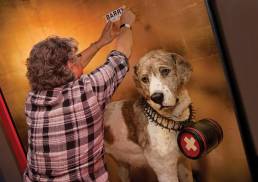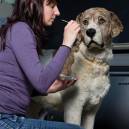Swiss Icon Barry
Rescue dog from the 1800’s receives recognition, and gets exhibition of his own.
By Deborah Stone
You may have heard of Barry der Menschenretter, as his fame is global. Over the years, poems and novels have been written about this legendary dog’s feats and movies have documented his prowess and courage. There’s even a monument to him that stands at the entrance of an elaborate pet cemetery outside of Paris. Regarded as the most well-known rescue animal in the world, Barry is also viewed as a symbol of Switzerland and a shining example of loyal help and service.
“Born in 1800 in the Hospice at the Great St. Bernard Pass, a charitable travelers’ shelter high in the Swiss Alps, Barry became a companion to local mountain guides, who helped those in need. Dogs such as Barry were originally of mixed breeds and their sturdy bodies, strength and excellent sense of direction were well-suited to the harsh and forbidding environment in which they worked. One of their most important tasks was to locate snow-covered paths and to break trails through deep snowdrifts. Upon discovering those travelers who had succumb to exhaustion and cold and become buried in the snow while attempting to cross the pass, the dogs would bark furiously to draw attention to these unfortunate souls. This special collaboration between man and dog proved to be extremely successful and over the next 200 years, more than 2,000 lives were saved within the region.
Of the dogs that assisted in this endeavor, Barry made an indelible impression on those who knew him. He was the most tireless helper and is credited with rescuing more than forty people from an icy death. After twelve years in the mountains, Barry left the Hospice. A monk took him to Bern, where he died peacefully at the ripe old age of fourteen. By then, he was already a household name to many. Subsequently, the head of the Hospice arranged for a taxidermy mount to be prepared for Barry’s posterity and put on display in the original Natural History Museum of Bern.











